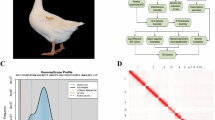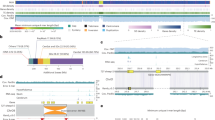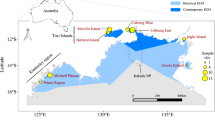Abstract
Telomere-to-telomere (T2T) assemblies reveal new insights into the structure and function of the previously ‘invisible’ parts of the genome and allow comparative analyses of complete genomes across entire clades. We present here an open collaborative effort, termed the ‘Ruminant T2T Consortium’ (RT2T), that aims to generate complete diploid assemblies for numerous species of the Artiodactyla suborder Ruminantia to examine chromosomal evolution in the context of natural selection and domestication of species used as livestock.
This is a preview of subscription content, access via your institution
Access options
Access Nature and 54 other Nature Portfolio journals
Get Nature+, our best-value online-access subscription
27,99 € / 30 days
cancel any time
Subscribe to this journal
Receive 12 print issues and online access
209,00 € per year
only 17,42 € per issue
Buy this article
- Purchase on SpringerLink
- Instant access to full article PDF
Prices may be subject to local taxes which are calculated during checkout

Similar content being viewed by others
References
Nurk, S. et al. The complete sequence of a human genome. Science 376, 44–53 (2022).
Gershman, A. et al. Epigenetic patterns in a complete human genome. Science 376, eabj5089 (2022).
Altemose, N. et al. Complete genomic and epigenetic maps of human centromeres. Science 376, eabl4178 (2022).
Hoyt, S. J. et al. From telomere to telomere: the transcriptional and epigenetic state of human repeat elements. Science 376, eabk3112 (2022).
Aganezov, S. et al. A complete reference genome improves analysis of human genetic variation. Science 376, eabl3533 (2022).
Vollger, M. R. et al. Segmental duplications and their variation in a complete human genome. Science 376, eabj6965 (2022).
Chen, J. et al. A complete telomere-to-telomere assembly of the maize genome. Nat. Genet. 55, 1221–1231 (2023).
Zhang, C. et al. The T2T genome assembly of soybean cultivar ZH13 and its epigenetic landscapes. Mol. Plant 16, 1715–1718 (2023).
Deng, Y. et al. A telomere-to-telomere gap-free reference genome of watermelon and its mutation library provide important resources for gene discovery and breeding. Mol. Plant 15, 1268–1284 (2022).
Nakandala, U. et al. Haplotype resolved chromosome level genome assembly of Citrus australis reveals disease resistance and other citrus specific genes. Hortic. Res. 10, uhad058 (2023).
Li, G. et al. The haplotype-resolved T2T reference genome highlights structural variation underlying agronomic traits of melon. Hortic. Res. 10, uhad182 (2023).
Li, B. et al. A gap-free reference genome reveals structural variations associated with flowering time in rapeseed (Brassica napus). Hortic. Res. 10, uhad171 (2023).
Alberto, F. J. et al. Convergent genomic signatures of domestication in sheep and goats. Nat. Commun. 9, 813 (2018).
Hackmann, T. J. & Spain, J. N. Invited review: ruminant ecology and evolution: perspectives useful to ruminant livestock research and production. J. Dairy Sci. 93, 1320–1334 (2010).
Minervino, A. H. H., Zava, M., Vecchio, D. & Borghese, A. Bubalus bubalis: a short story. Front. Vet. Sci. 7, 570413 (2020).
Gilbert, M. et al. Global distribution data for cattle, buffaloes, horses, sheep, goats, pigs, chickens and ducks in 2010. Sci. Data 5, 180227 (2018).
Graphodatsky, A., Perelman, P. & Obrien, S. J. in Atlas of Mammalian Chromosomes 706–857 (John Wiley & Sons, 2020).
Chen, L. et al. Large-scale ruminant genome sequencing provides insights into their evolution and distinct traits. Science 364, eaav6202 (2019).
Ker, D. F. E. & Yang, Y. P. Ruminants: evolutionary past and future impact. Science 364, 1130–1131 (2019).
Wang, Y. et al. Genetic basis of ruminant headgear and rapid antler regeneration. Science 364, eaav6335 (2019).
Lin, Z. et al. Biological adaptations in the Arctic cervid, the reindeer (Rangifer tarandus). Science 364, eaav6312 (2019).
Rhie, A. et al. Towards complete and error-free genome assemblies of all vertebrate species. Nature 592, 737–746 (2021).
Qiu, Q. et al. The yak genome and adaptation to life at high altitude. Nat. Genet. 44, 946–949 (2012).
Rice, E. S. et al. Continuous chromosome-scale haplotypes assembled from a single interspecies F1 hybrid of yak and cattle. Gigascience 9, giaa029 (2020).
Lejeune, J. et al. A proposed standard system of nomenclature of human mitotic chromosomes. Lancet 275, 1063–1065 (1960).
Cribiu, E. P. et al. International system for chromosome nomenclature of domestic bovids (ISCNDB 2000). Cytogenet. Cell Genet. 92, 283–299 (2001).
Brown, J. D. & O’Neill, R. J. Chromosomes, conflict, and epigenetics: chromosomal speciation revisited. Annu. Rev. Genomics Hum. Genet. 11, 291–316 (2010).
Potter, S. et al. Chromosomal speciation in the genomics era: disentangling phylogenetic evolution of rock-wallabies. Front. Genet. 8, 10 (2017).
Wurster, D. H. & Benirschke, K. Indian muntjac, Muntiacus muntjak: a deer with a low diploid chromosome number. Science 168, 1364–1366 (1970).
Vujosevic, M., Rajicic, M. & Blagojevic, J. B chromosomes in populations of mammals revisited. Genes 9, 487 (2018).
Bovine HapMap, C. et al. Genome-wide survey of SNP variation uncovers the genetic structure of cattle breeds. Science 324, 528–532 (2009).
Rexroad, C. et al. Genome to phenome: improving animal health, production, and well-being — a new USDA blueprint for animal genome research 2018–2027. Front. Genet. 10, 327 (2019).
Kalbfleisch, T. S. et al. A SNP resource for studying North American moose. F1000Res. 7, 40 (2018).
Cherry, S. G., Merkle, J. A., Sigaud, M., Fortin, D. & Wilson, G. A. Managing genetic diversity and extinction risk for a rare plains bison (Bison bison bison) population. Environ. Manage. 64, 553–563 (2019).
Theissinger, K. et al. How genomics can help biodiversity conservation. Trends Genet. 39, 545–559 (2023).
Paez, S. et al. Reference genomes for conservation. Science 377, 364–366 (2022).
Makova, K. D. et al. The complete sequence and comparative analysis of ape sex chromosomes. Nature 630, 401–411 (2024).
Rautiainen, M. et al. Telomere-to-telomere assembly of diploid chromosomes with Verkko. Nat. Biotechnol. 41, 1474–1482 (2023).
Cheng, H., Concepcion, G. T., Feng, X., Zhang, H. & Li, H. Haplotype-resolved de novo assembly using phased assembly graphs with hifiasm. Nat. Methods 18, 170–175 (2021).
Corbo, M., Damas, J., Bursell, M. G. & Lewin, H. A. Conservation of chromatin conformation in carnivores. Proc. Natl Acad. Sci. USA 119, e2120555119 (2022).
Foissac, S. et al. Multi-species annotation of transcriptome and chromatin structure in domesticated animals. BMC Biol. 17, 108 (2019).
Spielmann, M., Lupianez, D. G. & Mundlos, S. Structural variation in the 3D genome. Nat. Rev. Genet. 19, 453–467 (2018).
Shanta, O., Noor, A., Human Genome Structural Variation Consortium & Sebat, J. The effects of common structural variants on 3D chromatin structure. BMC Genomics 21, 95 (2020).
Anania, C. & Lupianez, D. G. Order and disorder: abnormal 3D chromatin organization in human disease. Brief. Funct. Genomics 19, 128–138 (2020).
Liao, Y., Zhang, X., Chakraborty, M. & Emerson, J. J. Topologically associating domains and their role in the evolution of genome structure and function in Drosophila. Genome Res. 31, 397–410 (2021).
Mattick, J. S. et al. Long non-coding RNAs: definitions, functions, challenges and recommendations. Nat. Rev. Mol. Cell Biol. 24, 430–447 (2023).
Tonegawa, S. Somatic generation of antibody diversity. Nature 302, 575–581 (1983).
Safonova, Y. et al. Variations in antibody repertoires correlate with vaccine responses. Genome Res. 32, 791–804 (2022).
Sok, D. et al. Rapid elicitation of broadly neutralizing antibodies to HIV by immunization in cows. Nature 548, 108–111 (2017).
Clark, T. A. et al. Characterization of DNA methyltransferase specificities using single-molecule, real-time DNA sequencing. Nucleic Acids Res. 40, e29 (2012).
Lee, W. C. et al. The complete methylome of Helicobacter pylori UM032. BMC Genomics 16, 424 (2015).
Payelleville, A. et al. The complete methylome of an entomopathogenic bacterium reveals the existence of loci with unmethylated adenines. Sci. Rep. 8, 12091 (2018).
Rand, A. C. et al. Mapping DNA methylation with high-throughput nanopore sequencing. Nat. Methods 14, 411–413 (2017).
Simpson, J. T. et al. Detecting DNA cytosine methylation using nanopore sequencing. Nat. Methods 14, 407–410 (2017).
Tvedte, E. S. et al. Comparison of long-read sequencing technologies in interrogating bacteria and fly genomes. G3 11, jkab083 (2017).
Konstantinidis, I. et al. Major gene expression changes and epigenetic remodelling in Nile tilapia muscle after just one generation of domestication. Epigenetics 15, 1052–1067 (2020).
Janowitz Koch, I. et al. The concerted impact of domestication and transposon insertions on methylation patterns between dogs and grey wolves. Mol. Ecol. 25, 1838–1855 (2016).
Hayes, B. J. & Daetwyler, H. D. 1000 Bull Genomes Project to map simple and complex genetic traits in cattle: applications and outcomes. Annu. Rev. Anim. Biosci. 7, 89–102 (2019).
Daetwyler, H. D. et al. Whole-genome sequencing of 234 bulls facilitates mapping of monogenic and complex traits in cattle. Nat. Genet. 46, 858–865 (2014).
Nguyen, T. V. et al. In it for the long run: perspectives on exploiting long-read sequencing in livestock for population scale studies of structural variants. Genet. Sel. Evol. 55, 9 (2023).
Davenport, K. M. et al. An improved ovine reference genome assembly to facilitate in-depth functional annotation of the sheep genome. Gigascience 11, giab096 (2022).
Guhlin, J. et al. Species-wide genomics of kākāpō provides tools to accelerate recovery. Nat. Ecol. Evol. 7, 1693–1705 (2023).
Hogg, C. J. et al. Threatened Species Initiative: empowering conservation action using genomic resources. Proc. Natl Acad. Sci. USA 119, e2115643118 (2022).
Lewin, H. A. et al. Earth BioGenome Project: sequencing life for the future of life. Proc. Natl Acad. Sci. USA 115, 4325–4333 (2018).
Zurano, J. P. et al. Cetartiodactyla: updating a time-calibrated molecular phylogeny. Mol. Phylogenet. Evol. 133, 256–262 (2019).
Acknowledgements
This research was supported by the Intramural Research Program of the US Department of Agriculture, National Institute of Food and Agriculture (grant 2023-67015-39000). Any mention of trade names or commercial products is solely for the purpose of providing specific information and does not imply recommendation or endorsement by the US Department of Agriculture. The USDA is an equal-opportunity provider and employer.
Author information
Authors and Affiliations
Contributions
All correspondence should be addressed to B.D.R., R.J.O’N. or T.P.L.S. T.S.K., S.D.M., B.M.M., D.L.A., D.A., G.B., L.M.B., M.J.B.-G., F.B., T.C., E. Chuong, E. Clark, S.C., N.C., C.C., B.W.D., C.G.E., T.F., Y.G., C.G., P.G., J.G., R.G., D.G., D.H., G.A.H., M.H., S.J.H., W.H., E.J., J. Kalleberg, H.K., K.-P.K., J. Koltes, S.K., C.K., T.L., A.L., G.E.L., W.Y.L., H.M., K. McRae, K. Miga, M.M., H.N., T.O., M. Pennell, B.P., M. Pewsner, A.M.P., B.D.P., P.P., T.P., S.R., A. Rhie, M.R., A. Robic, N.R.O., Y.S., G.S., R.D.S., N.S.N., M.S., J.S., P.S., C.S., G.T.-K., G.M.T., C.K.T., C.P.V.T., C.W., R.W., K.W., S.X., L.Y., T.P.L.S., R.J.O’N. and B.D.R. contributed to the vision and framing of the RT2T Consortium and the Perspective.
Corresponding authors
Ethics declarations
Competing interests
T.S.K., S.D.M., B.M.M., D.L.A., D.A., G.B., L.M.B., M.J.B.-G., F.B., T.C., E. Chuong, E. Clark, S.C., N.C., C.C., B.W.D., C.G.E., T.F., Y.G., C.G., J.G., R.G., D.G., D.H., G.A.H., M.H., S.J.H., W.H., E.J., J. Kalleberg, H.K., K.-P.K., J. Koltes, C.K., T.L., A.L., G.E.L., W.Y.L., H.M., K. McRae, K. Miga, M.M., H.N., T.O., M. Pennell, B.P., M. Pewsner, A.M.P., B.D.P., P.P., T.P., S.R., A. Rhie, M.R., A. Robic, N.R.O., Y.S., G.S., R.D.S., N.S.N., M.S., J.S., P.S., C.S., G.T.-K., G.M.T., C.K.T., C.P.V.T., R.W., K.W., S.X., L.Y., T.P.L.S., and B.D.R. have no competing interests to declare. P.G. is an employee of Colossal Biosciences and Form Bio and has received travel funds to speak at events hosted by Oxford Nanopore Technologies. S.K. and R.J.O’N. have received travel funds to speak at events hosted by Oxford Nanopore Technologies. R.J.O’N. serves on the scientific advisory board of Colossal Biosciences. C.W. is a cofounder and the chief scientific officer of Clareo Biosciences.
Peer review
Peer review information
Nature Genetics thanks Ruidong Xiang, Lingzhao Fang, Tuan V. Nguyen, and the other, anonymous, reviewer(s) for their contribution to the peer review of this work.
Additional information
Publisher’s note Springer Nature remains neutral with regard to jurisdictional claims in published maps and institutional affiliations.
Rights and permissions
About this article
Cite this article
Kalbfleisch, T.S., McKay, S.D., Murdoch, B.M. et al. The Ruminant Telomere-to-Telomere (RT2T) Consortium. Nat Genet 56, 1566–1573 (2024). https://doi.org/10.1038/s41588-024-01835-2
Received:
Accepted:
Published:
Issue Date:
DOI: https://doi.org/10.1038/s41588-024-01835-2
This article is cited by
-
CloseRead: a tool for assessing assembly errors in immunoglobulin loci applied to vertebrate long-read genome assemblies
Genome Biology (2025)
-
Telomere-to-telomere sheep genome assembly identifies variants associated with wool fineness
Nature Genetics (2025)
-
The Farm Animal Genotype–Tissue Expression (FarmGTEx) Project
Nature Genetics (2025)
-
A genome assembly and transcriptome atlas of the inbred Babraham pig to illuminate porcine immunogenetic variation
Immunogenetics (2024)
-
Telomere-to-telomere assemblies of cattle and sheep Y-chromosomes uncover divergent structure and gene content
Nature Communications (2024)



